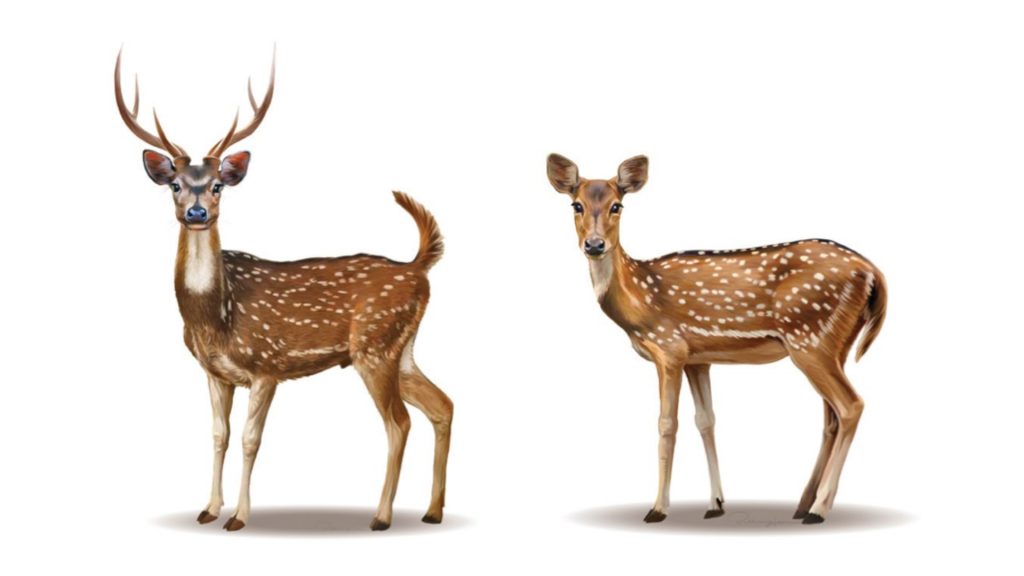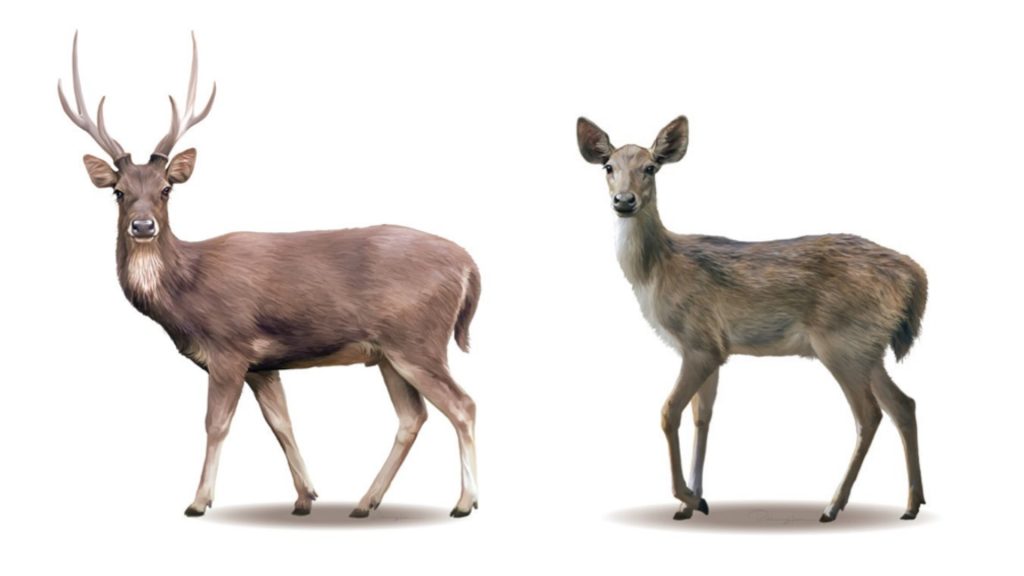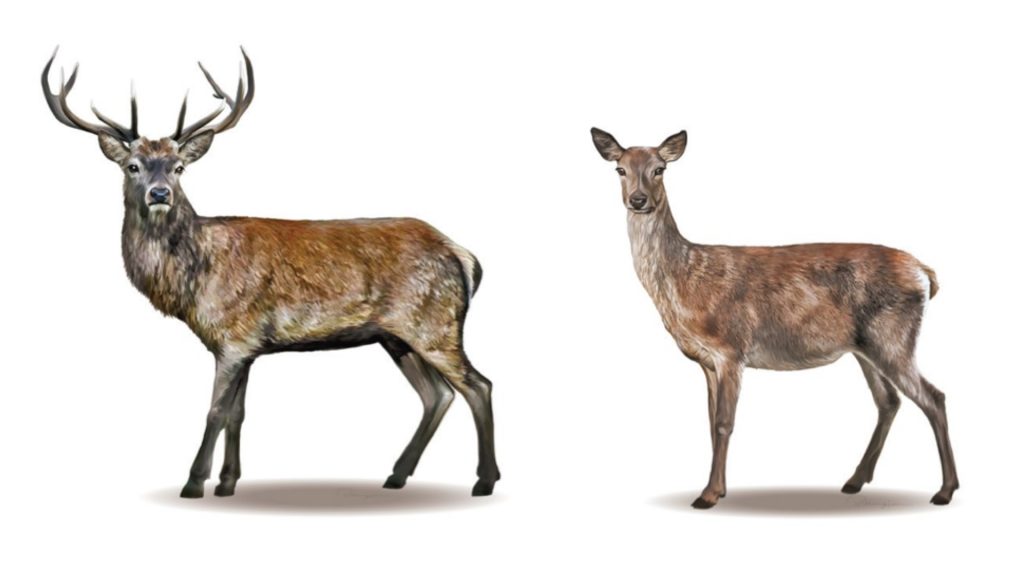
Identifying Deer Species
Six species of feral deer are established in Australia: Fallow, Chital, Rusa, Red, Hog and Sambar deer.
The different species can have varying impacts to the environment, different population densities and spread and can be associated with different control measures. Therefore, it is important that, where possible, the correct deer species is identified.
This page contains a list of the six species with descriptions on how best to identify them. You can also download out field guide by clicking below.

Fallow Deer (Dama dama)

Size – Males can grow to a height of 95cm and a weight of 100kg.
Antlers – Multi-tined, upper half palmate or flattened. Cast in October, reformed by February. Up to 50cm.
Appearance – Coat colour highly variable, from black, to reddish brown with white spots, to lighter brown (menil) with white spots to white. Coat colour variants can be universally present in a single herd. Black and white markings on tail and buttocks prominent. While feeding tail is flicked continuously. ‘Adam’s Apple’ strikingly prominent in throat of adult stags. In rut, the buck makes an unmistakable croak, similar to a grunting pig. The calls vary from high pitched bleating to deep grunts.
Habitat – Open forest and woodland with grassy understory. Woodland edge adjacent to grassland.
Social Behaviour – Outside breeding season (mid-April through to August) herds segregate into groups containing females and their offspring and groups containing bachelor males.
Chital Deer (Axis axis)

Size – Can grow to a height of 95cm and a weight of 100kg.
Antlers – Flattened antlers up to 50cm with numerous points.
Appearance – Reddish brown to chestnut brown coat with dark brown/black muzzle white spots. Heart shaped pale rump patch with black outline. Males have a striking white throat patch. Long tail. Have a distinctive high-pitch alarm call when disturbed.
Habitat – Graze on a variety of grasses, fruit and leaves.
Social Behaviour – They can form herds of more than 100. Females separate from the herd during birthing and rearing of their young.
Rusa Deer (Rusa Timorensis)

Size – Males can grow to a height of 110cm and a weight of 135kg.
Antlers – Three lyre-like tines. Rear tine on forked pair is always longer than front tine. Round in section. Up to 96cm.
Appearance – Coat colour varies seasonally. Summer coat colour reddish-brown, darkening on hindquarters and lightening on chest with white throat spots. Winter coat is thicker and upper parts are greyer. Stags often develop thick mane. Newborn calves have a rich red coat colour.
Habitat – Cleared grassy areas but also heathlands, woodlands, forests and rainforest.
Social Behaviour – Outside breeding season stags remain segregated from hinds and their offspring. Often seen in small groups.
Red Deer (Cervus elaphus)

Size – Males can grow to a height of 120cm and a weight of 220kg.
Antlers – Multi-tined, six to eight tines common, 10-12 less frequent. Round in section. Cast in October or November, reformed by February. Up to 90cm.
Appearance – Coat colour changes seasonally, being reddish in summer and greyish brown in winter. Regardless of time of year, a lighter yellow-coloured rump patch is prominent. Calves have white spots along flanks when first-born, which tend to fade within a few months. Tail is small and indistinct. Ears long and pointed.
Habitat – Open forest and woodland with grassy understory. Woodland edge adjacent to grassland. They may be seen in open areas but usually only when it’s close to thick, timbered vegetation.
Social Behaviour – Outside breeding season (mainly April) stags remain segregated from hinds and their offspring, with hinds forming matriarchal herds. Males are often territorial during mating season and roar to attract receptive females.
Hog Deer (Axis porcinus)

Size – The shortest species of deer. Males can grow to a height of 70cm and a weight of 55kg.
Antlers – Typically short, around 30-35cm with usually three points on each site.
Appearance –In summer the coat colour is a uniform yellowish brown to reddish-brown. Sometimes pale cream spots may be present. In winter, coat colour is dark brown. Newborn calves have white spots. Tail rather long in proportion to body, white underneath and at tip.
Habitat –Typically found along the coast in freshwater and saltwater marshlands, heathland, woodlands and forests, often adjacent to farmland
Social Behaviour –Typically solitary or in small groups. Larger congregations of animals may occur where food is locally abundant
Sambar Deer (Rusa unicolor)

Size – The largest species of deer. Males can grow up to 160cm and a weight of 300kg.
Antlers – Up to 70cm with three tines per antler – a single brow tine and a terminal forked set of tines.
Appearance – Coat colour is uniformly dark brown, though lighter coloured on the belly and the inner sides of each leg. Characteristic large rounded ears, about half the length of the head. When disturbed, individuals will raise bushy tail over back and rump-hair will flare.
Habitat –Widespread and adaptable species. Though often associated with tall wet eucalypt forest, often occurs at the edges of farmlands, and is known to inhabit heathland, woodland, dry forest and rainforest.
Social Behaviour – Solitary or in small groups. Outside breeding season stags remain segregated from hinds and their offspring. During breeding cycle, adult stags attract multiple hinds.
National Feral Deer Action Plan
Developing Australia’s Management Strategy
